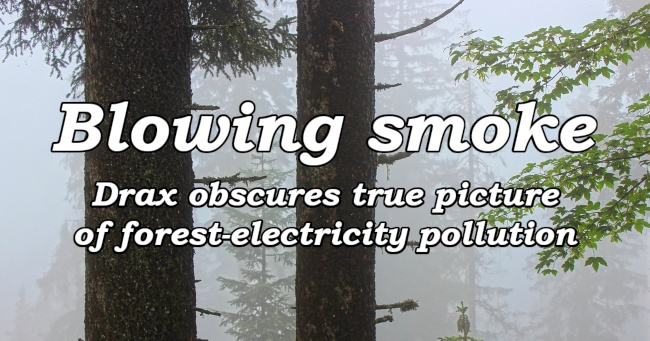| Take Action |
| Donate |
It may at first strike many observers as farfetched: The notion that burning wood to generate electricity is actually more climate-polluting than fossil fuels—even including coal.
After all, humans have been burning wood for warmth and cooking for millennia. "Hearth" is almost synonymous with "home."
But the energy density of wood is less than coal. So compared to coal a great deal of wood, by volume, must be burned to generate an equivalent number of kilowatts. Even biomass electricity giants such as Drax Group don't really dispute this.
Rather, the industry rests its "green electricity" claim on the fact that trees grow back, which is highly misleading.
California's forests are in the crosshairs. Drax is eyeing them as a new frontier for sourcing the raw material needed to make wood pellets to burn to generate electricity. The U.K.-based company's local booster is Golden State Natural Resources (GSNR), a California nonprofit whose board consists of rural county supervisors. GSNR is promoting and fundraising for the construction of two enormous pellet plants in California.
Most trees take decades to grow to maturity and, roughly speaking, centuries to reach "old-growth" status. While that many years roll by after an area is logged, most of the CO2 emitted from the initial wood burning stays in the atmosphere, causing global heating. Meanwhile, more trees have been felled and burned, adding more CO2 to the atmosphere.
For reabsorption of all the initially released CO2 to occur would require a halt to new emissions until regrowth could catch up. But civilization doesn't have decades to hang on for such a scenario to magically occur. The reality we thus confront is an ongoing "carbon debt."
Moreover, none of this fully takes into account the carbon emitted from cutting and transporting trees to pellet mills, manufacturing the pellets, transporting them by ground and sea to their destinations for burning, and more.
It also does not account for the immense damage to forest ecosystems, soils, wildlife, and water quality from cutting down carbon-absorbing forests.
Perhaps more surprising than the science of wood-vs.-coal CO2 emissions per kilowatt, massive accounting errors have led to the official view in the European Union (E.U.) that biomass electricity is "green." In essence that error consists in counting emissions only in the countries where the wood was sourced (principally the U.S. and Canada), not where it was burned (the U.K.).
The E.U. has a strong incentive to meet its emissions targets under the Paris Agreement of 2015.
Drax, regarded as a "zero-emission" company, is the largest CO2 emitter in the U.K.'s power sector even though less than five percent of U.K. power is generated from biomass. At the same time, biomass accounts for some 20 percent of U.K. power sector emissions. Drax in 2022 emitted over 12 million tons of carbon dioxide.
See our RESOURCES section at bottom of this alert for more information about the climate impacts of burning trees for kilowatts.
We can and must stop this highly climate-damaging scheme, which also threatens all the other values of forest ecosystems. We have an immediate opportunity to stop Drax—an upcoming assessment, now overdue, by the U.S. Treasury Department as to whether the popular Inflation Reduction Act of 2022 (IRA) will direct funds to construction of these proposed new biomass facilities.
The fact that humans have been burning wood for millennia and that trees grow back have created a convenient framework for a comforting narrative to arise that industrial wood-burning to generate power is renewable and "green."
Today's urgency to reverse the climate crisis has amplified this false narrative, as has the notion that wildfires have created vast storehouses of "wasted" woody material which can be "put to good use" to generate electricity. (Dead wood provides essential ecological functions in forests.)
The cold hard truth hasn't changed and the distraction of biomass electricity won't change it: We must relinquish fossil fuels as quickly as possible while aggressively developing truly green energy such as solar and wind, coupled with conservation and energy efficiency.
This remains the real way forward.
| Take Action |

Paul Hughes
Executive Director
Forests Forever
| Your contribution today will help California's forests thrive! | |
|
RESOURCES →
- EMBER reports that Drax's Yorkshire biomass plant is the U.K. power sector's top CO2 emitter.
- Almost 800 scientists worldwide penned this 2018 letter to the European Union Parliament warning of the hazards of forest biomass electricity.
- This authoritative study asks, "Does replacing coal with wood lower CO2 emissions?"
- Here's an in-depth report by the Rachel Carson Council, "Greenwashing: A Report on the Corporate Selling of Polluting Wood Pellet Production"
- Forests Forever's latest alert on this issue is here. The one before that is here, and the one prior to that here.
